#Amelia Bloomer
Explore tagged Tumblr posts
Text
And there were even corsets made for sport activities and corsets made for summer (more of skeletal design with thin matterial, rather than complete layered lining), but that would be nineteenth century upper mid and upper class. Most people, esp. pre-industrial revolution, would be happy they've got one in the first place. And beside back and posture in general it also nicely supported breasts - less strain on shoulders than bra. And why, yes, it does shape one's figure, sure and there's nothing anti-feministic about having some ideal of beauty. If anything this was less invasive than surgeries or dieting. As for skirts... I would add that beside narrow long ones a wearer could run into a problem with number of undergarments used for the sake of creating volume. I had a reenactor tell me, her gothic costume slowed her down somewhat. Then there is that time in la belle epoque, when fashionable shape required increasing amount of underskirts (and even led to a small movement of short skirt + wide pants (named after Amelia Bloomer)) until crinoline was invented. Which would concern upper mid and upper classes, but it could also explain part of that impracticality myth. Like yeah, running in ten voluptous petticoats instead of one or two simple ones ain't gonna be the most comfortable experience. That said, when it comes to petticoats and outter skirts, they allowed for lotsa space in pockets, which actually is practical for carrying around all sorts of things. When it comes to pants, there is sense of victory in winning over crossdressing bans and un-femininity taboo. But it is stupid to throw skirt away altogether just because at some point females in trousers were frowned upon.
Feminist fantasy is funny sometimes in how much it wants to shit on femininity for no goddamned reason. Like the whole “skirts are tools of the patriarchy made to cripple women into immobility, breeches are much better” thing.
(Let’s get it straight: Most societies over history have defaulted to skirts for everyone because you don’t have to take anything off to relieve yourself, you just have to squat down or lift your skirts and go. The main advantage of bifurcated garments is they make it easier to ride horses. But Western men wear pants so women wearing pants has become ~the universal symbol of gender equality~)
The book I’m reading literally just had its medievalesque heroine declare that peasant women wear breeches to work in the field because “You can’t swing a scythe in a skirt!”
Hm yes story checks out
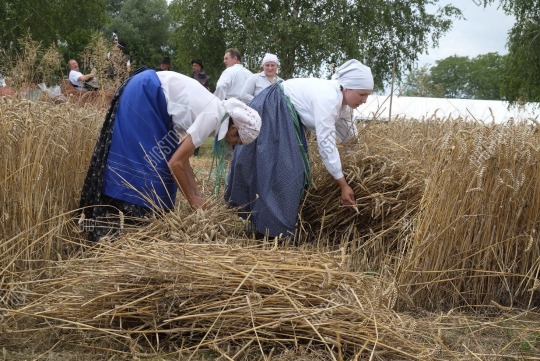
peasant women definitely never did farm labour in skirts
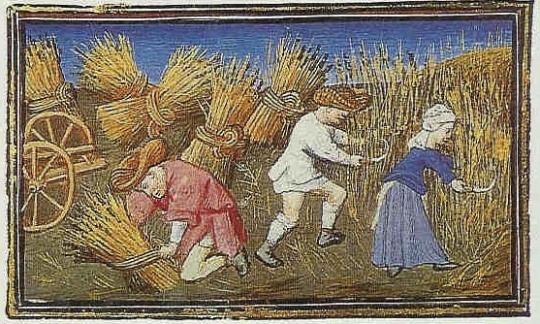
skirts definitely mean you’re weak and fragile and can’t accomplish anything

skirts are definitely bad and will keep you from truly living life

no skirts for anyone, that’s definitely the moral of the story here
#skirt#trousers#corset#historical fashion#Amelia Bloomer#cross-cultural#feminism#practicality#petticoats
97K notes
·
View notes
Text
Abolitionist / Anti-Slavery Amelia Bloomer
One question that I never completely resolved for myself while studying Bloomer’s life was whether she would qualify as an abolitionist, or as only anti-slavery. I decided to present evidence to the readers, without a definite argument either way. As with any controversial and significant subject, here were many different sets of overlapping beliefs among those opposed to slavery in the 1840s…

View On WordPress
#abolition#abolitionism#Amelia Bloomer#Civil War#feminism#Fugitive Slave Act#history#slavery#suffragists
0 notes
Text
Happy Bloomer Day
Bloomer Day commemorates the birth of Amelia Jenks Bloomer, American women's rights and temperance advocate, who popularised the “bloomers'' garment that bears her name, on this date in 1818. 10 things you might not know:
0 notes
Text
Word List: Fashion History
to try to include in your poem/story (pt. 1/3)
Adinkra - a flat, cotton textile that is stamped with symbols which create the meaning of the garment; produced by the Asante peoples in Ghana
Agal - a rope made from animal hair which wraps around a keffiya (square cloth) on the head and is worn typically by Bedouin men
Akwete - a decorative cloth with complex weave designs, creating intricate geometric patterns, made with many vibrant colors; it is usually made into wrappers for women to wear and it is made by the Igbo women of Nigeria
Aniline Dyes - synthetic, chemical dyes for garments first invented in the 19th century
Anorak - a jacket that typically has a hood, but not always, which was originally worn by the indigenous peoples of the Arctic designed to keep them warm and protected from harsh weather
Back Apron (Negbe) - an oval-shaped decorative pad worn by Mangbetu women over the buttocks in Central Africa
Backstrap Loom - a lightweight, mobile loom made of wood and a strap that is wrapped around the back; it only needed to be attached to a tree or a post for stability and to provide tension
Banyan - a loose-fitted informal robe or gown typically worn by men in the late 17th to the early 19th centuries
Barbette - a piece of linen which passes under the chin and is pinned at the sides, usually worn in conjunction with additional head coverings during the Middle Ages
Bark Cloth - fabric made out of bark from trees
Beadnet Dress - a decorative sheath dress made of beads worn in ancient Egypt
Bloomers - a bifurcated garment that were worn under dresses in the 19th century; they soon became a symbol of women’s rights because early activist Amelia Bloomer wore drawers long enough to stick out from under her dress
Bogolanfini - (bogolan- meaning cloth; fini- meaning mud) a cotton cloth made from strips of woven fabric, which are decorated with symbolic patterns using the mud-resist technique, sewn together at the selvage to create a fabric that is utilized during the main four stages of a West African Bamana woman’s life: puberty, marriage, motherhood, and death
Bombast/Bombasted - the padding used to structure clothing and create fashionable silhouettes in the 16th and 17th centuries
Boubou - an African robe made of one large rectangle of fabric with an opening in the center for the neck; when worn it drapes down over the shoulders and billows at the sleeves
Buff Coat - a leather version of the doublet that was often, but not exclusively, worn by people in the military in the 17th century
Bum Roll - a roll of padding tied around the hip line to hold a woman’s skirt out from the body in the late 16th and early 17th centuries
Burqa - an outer garment worn by Muslim women that covers the entire body, often with a cutout or mesh at the eyes
Busk - a flat length stay piece that was inserted into the front of a corset to keep it stiff from the 16th century to the early 20th century
Bustle - a pad or frame worn under a skirt puffing it out behind
Cage Crinoline - a hooped cage worn under petticoats in the 19th century to stiffen and extend the skirt
Caraco - 18th century women’s jacket, fitted around the torso and flared out after the waist
Carrick Coat - an overcoat with three to five cape collars popular in the 19th century and mostly worn for riding and travel–sometimes called a Garrick or coachman’s coat
Chantilly Lace - a kind of bobbin lace popularized in 18th century France; it is identifiable by its fine ground, outlined pattern, and abundant detail, and was generally made from black silk thread
Chaperon - a turban-like headdress worn during the Middle Ages in Western Europe
Chemisette - a piece of fabric worn under bodices in the 19th century to fill in low necklines for modesty and decoration
Chiton - an ancient Greek garment created from a single piece of cloth wrapped around the body and held together by pins at the shoulders
Chlamys - a rectangular cloak fastened at the neck or shoulder that wraps around the body like a cape
Chopines - high platform shoes worn mostly in Venice in the 16th & 17th centuries
Clavus/Clavi - decorative vertical stripes that ran over the shoulder on the front and back of a Late Roman or Byzantine tunic
Clocks/Clocking - decorative and strengthening embroidery on stockings in Europe and America during the 16th-19th centuries
Cochineal Dyes - come from the Cochineal beetle that is native to the Americas and is most commonly found on prickly pear cacti; when dried and crushed, it creates its famous red pigment that is used to dye textiles
Codpiece - originally created as the join between the two hoses at the groin, the codpiece eventually became an ornate piece of male dress in the 16th century
Cuirass Bodice - a form-fitting, long-waisted, boned bodice worn in the 1870s and 1880s–almost gives the appearance of armor as the name suggests
Dagging - an extremely popular decorative edging technique created by cutting that reached its height during the Middle Ages and Renaissance
Dalmatic Tunic - a t-shaped tunic with very wide sleeves; worn by both men and women during the Byzantine empire
Dashiki - a loose-fitting pullover tunic traditionally worn in West African cultures that was adopted by African diasporic communities as a symbol of African heritage in the 1960s and then more widely worn as a popular item of “ethnic” fashion
Dentalium Cape - or dentalium dress is a garment worn by Native American women that is made from the stringing together of dentalium shells in a circular pattern around the neck and across the chest and shoulders
Doublet - an often snug-fitting jacket that is shaped and fitted to a man’s body–worn mostly in the 15th to 17th centuries
Échelle - a decorative ladder of bows descending down the stomacher of a dress; worn during the late 17th and 18th centuries; sometimes spelled eschelle
If any of these words make their way into your next poem/story, please tag me, or leave a link in the replies. I would love to read them!
More: Fashion History ⚜ Word Lists
#word list#fashion history#writeblr#dark academia#spilled ink#writers on tumblr#writing prompt#terminology#poetry#poets on tumblr#literature#light academia#studyblr#linguistics#lit#words#fashion#culture#worldbuilding#creative writing#writing reference#fiction#writing tips#writing advice#writing resources
275 notes
·
View notes
Text


For the people saying wearing men's clothing has never been revolutionary or being a trans man just affirms the patriarchy, here's an example showing the exact opposite attitude ^

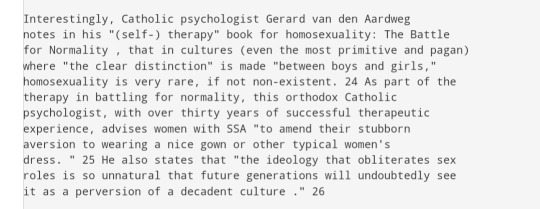
This too
PS: also look up Amelia Bloomer
#transfeminism#butchphobia#anti transmasculinity#transandrophobia#last one doesnt apply here exactly but the way yall use it does#this also just. regular ol misogyny. obviously. but yknow. for reach#transmisogyny#for the last screenshot at the end#bit about the “boys” with GID
45 notes
·
View notes
Note
Friend Marzi, why do we have an inclination to believe that all historical clothing was very heavy? Fabrics varied in lightness and for the very heat of summer for example an all-silk or all-muslin ensemble could be made very light and breathable if necessary, even foregoing implements like boning, etc. Like, there are ways to not be dragging your skirts around.
Working people and people with active hobbies were already wearing fewer layers anyway, so we shouldn't expect them to be encumbered. Why do we anyway?
Friend Tumblr User Chasingtheskyline! Hello!
(This answer will focus primarily on conventionally feminine clothing, since that's my area of expertise. Just to disclaim.)
I think it's because of the layering, really. And the idea that, as you touched on, Only Rich People Wore All That (not so much- the basic makeup of chemise/combinations, maybe drawers post-1820s, corset/stays, at least one petticoat, skirt, bodice for women was pretty consistent across most of the social ladder during the 18th and 19th centuries at least) so of COURSE it's heavy and impractical. And as we all know, rich people didn't have lives or do things! They just lounged around being rich and not moving! </s>
We're used to one layer of our mostly-polyester clothing being extremely warming in summer because. It's polyester. Breathability is not something people think about much nowadays, since we're so used to just exposing as much skin as possible to cool down. Ergo, the idea that it's layers of lightweight fabric doesn't really occur to people, I think.
Another element, I think, may be that some of these people have carried reproduction historical garments but never worn them. Or weighed them in a heap on a scale- yes, really -and never taken into account the weight distribution when they're on a body. I've owned garments that were a bear to carry, but perfectly comfortable to wear.
Also, you know. We've long had a vested interest in making our own garments seem like The Best Most Advanced Garments. You can find articles from as early as the 1920s decrying Victorian "trailing skirts and trailing hair" as unhygienic and uncomfortable Never mind that the ADULTS saying this would have known full well that shorter skirts were commonplace for situations where Excessive Dirt would be present and grown women wore their hair up. (Also, you know. Unless you're licking your hem, your skirts cannot get you sick.)
Either you're getting only the experiences of women who hated what they wore before- which would somehow be the same fashion writers who once declared that the gowns of 1915 were the best, or 1910, or 1905 -or they had a vested interest in selling something to the public: in this case, the hottest, newest clothes (and hairstyles that required more regular trips to the hairdresser than long hair pinned up). Of course you get those writers calling earlier clothing heavy- they're trying to get people to buy rayon flapper dresses!
Now, does that mean that nobody in history found their clothing heavy? Of course not. One of Amelia Bloomer's key complaints about the fashions of the 1840s and early 50s was the many layers of petticoats women often wore to create the fashionable skirt shape- and while I'm often loath to take dress reformers as sole arbiters of women's opinion, the invention of the cage crinoline/hoop skirt was widely hailed as a marvel for enabling big skirts with much less weight.
But you're so right that this perception is extremely exaggerated nowadays. I do my best to fight it- had this conversation with a colleague today, as I was wearing a long-sleeved blouse of cotton voile and a long cotton skirt to work in 80-degree (F) weather -but. Well. It DOES get frustrating at times.
128 notes
·
View notes
Text
March is Women’s History Month and the first newspaper in the United States that was edited by and published for women was called “The Lily.” Published monthly in Seneca Falls, New York, the driving force behind The Lily was Amelia Bloomer.
While the newspaper initially focused on spreading ideals of temperance, it soon broadened its attention to include many women’s rights issues of the time including suffrage and clothing reform. Circulation of the paper grew as discussions of a certain clothing outfit were published and popularized by Amelia Bloomer called “bloomers.”
The distribution of The Lily rose from 500 printed copies per month to 4,000 per month because of the bloomers dress reform controversy. The newspaper moved to different locations and had different owners from 1853 until The Lily published its final edition on December 15, 1856.
In this video, Jared discusses the history of The Lily and letterpress prints “THE LILY” using 15 line wood type made by the Hamilton Wood Type Company in the 1880s. This was printed with black rubber base ink using our Washington hand press, which is a very similar press that would have been used to print the newspaper.
#women’s history month#history#museum#sacramento#art#letterpress#printing#asmr#printmaking#typography#women’s history#newspaper
115 notes
·
View notes
Photo
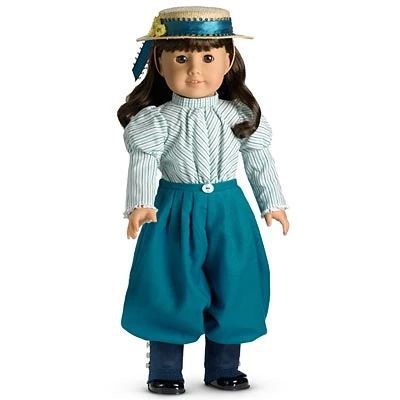
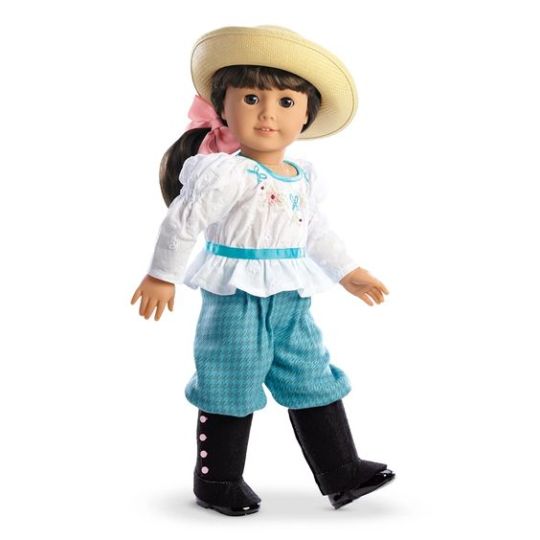
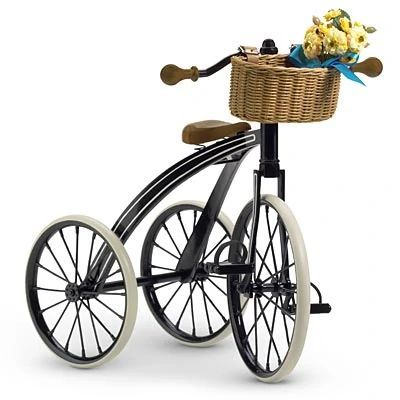
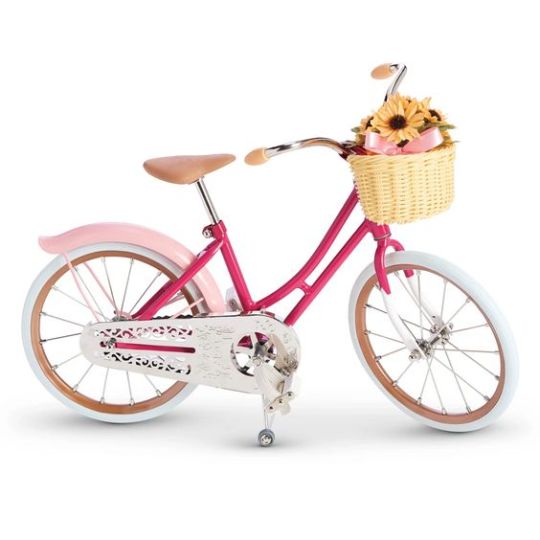
Samantha first rode a bike in the short story “Samantha’s Blue Bike” which was published in American Girl magazine in 1995. The story has her struggling to ride a bike with her long skirts getting caught in the chain, but ends with Grandmary relenting and letting Samantha wear bloomers.
With the invention of the safety bicycle in 1885 (which was lower to the ground and easier to control than the penny farthing), bicycling immediately took off as a popular activity for both men and women. It was a way for the independent “modern woman” to go out by herself and socialize on her own terms.
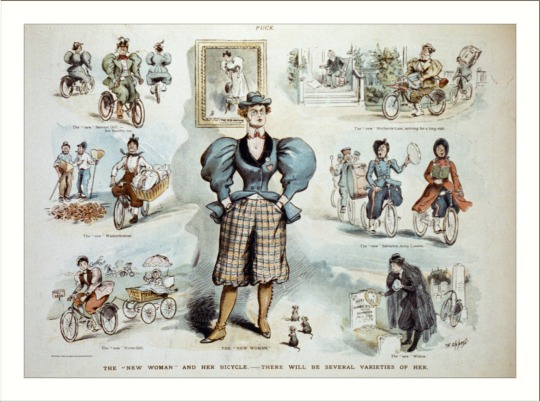
(hd version here)

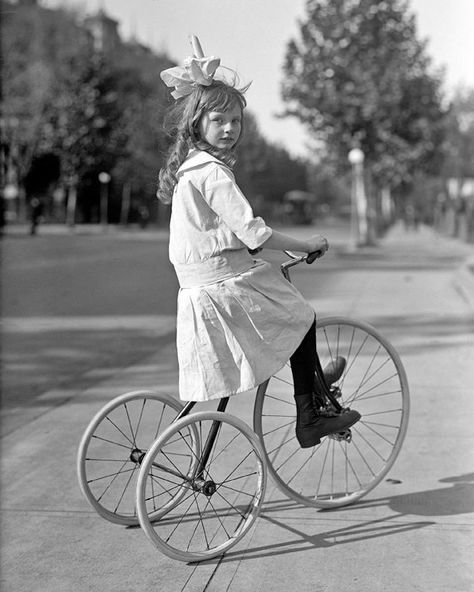
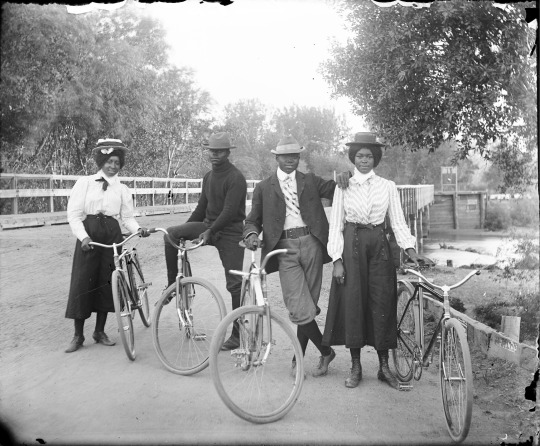
It also brought its own special apparel. It finally brought about the dress reform that women like Amelia Bloomer had been calling for for ages, allowing for comfortable clothing that weren’t as restrictive for women.


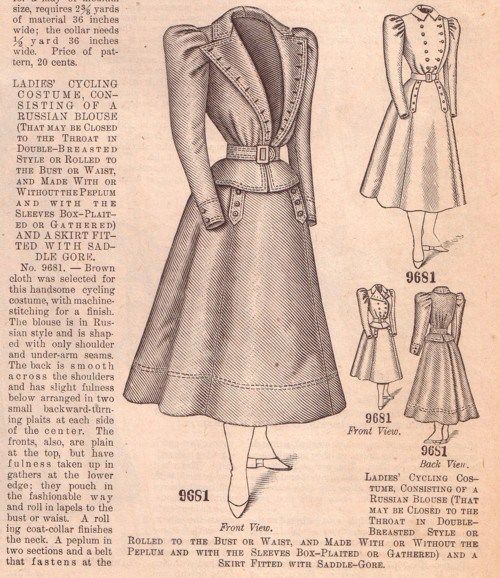
Most bicycling outfits were done in dark menswear tweeds to help cover dirt.
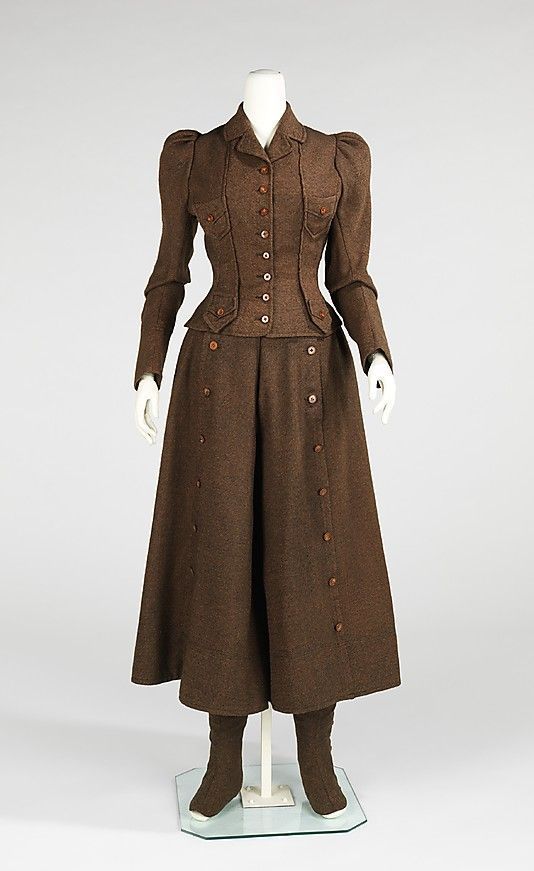
(The Met Museum)
but many were worn with an athletic blouse or sweater
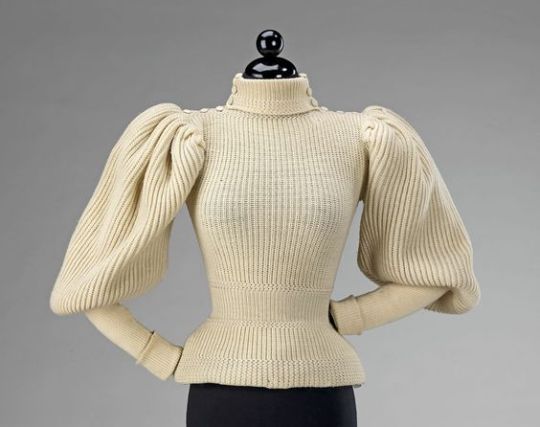
(The Met Museum)
Samantha’s first bicycling outfit is colorful, but bicycling suits could be very colorful, if not downright tacky!


(The FIDM Museum)
The second one however, is way more modern peasant blouse than 1904 bicycling outfit. And in the short story, Samantha’s bike is BLUE, why does the toy one have to be so PINK?!
504 notes
·
View notes
Text
i love historical fashion but some of these historical costuming people seem like if they had been alive in the 19th century, they would have been complaining that amelia bloomer hated femininity and didn’t want women to have fun.
like amelia bloomer and other dress reformers wore outfits that were fairly similar to mainstream women’s fashion, just with shorter dresses and pants underneath. and they were RIDICULED. clearly 19th century women were not exercising a free choice to wear corsets and crinolines. it took a lot of courage for them to rebel against those conventions.
it’s no different from a woman today claiming that her decision to shave is entirely personal and not influenced by society. but what would happen if you didn’t? your relatives might make comments (mine do), your boyfriend might be disgusted (mine was), people might look at you funny in public. shave if you want but realize that it’s a socially conditioned choice, bc, believe it or not, We Live In A Society.
319 notes
·
View notes
Text
Bloomer and the Spoils System
I did not expect the spoils system to end up in the news. But I do keep saying the current government wants us back in the 1850s so I suppose I should not be surprised. I learned about the spoils system when I researched Amelia Bloomer’s job at the Seneca Falls Post Office. A spoils system is the practice of awarding government jobs to political supporters after an election. In the United…
0 notes
Text
Hogwarts Legacy MC: Evelyn Damaris

General
Full Name: Evelyn Ophelia Damaris Nicknames: Evy (pronounced eh-vee) Date of Birth: 20th April 1875 (Taurus) Gender: Female (she/her) Nationality: English Blood Status: Half-blood House: Hufflepuff Wand: Soft spiral (warm brown), hazel wood, phoenix feather, reasonably supple, twelve and quarter inches, arrow brown handle Patronus: Siberian cat Likes: Defence Against the Dark Arts, Charms, Potions, reading, cooking, baking, and playing piano Dislikes: Brussels sprouts, bullies, isolation, Traits: Kind, loyal, strong, studious, protective, trusting, helpful
Appearance
Hair: Auburn, long, straight, medium thickness Eyes: Aqua Height: 5’4’’ Physique: Light skinned, lithe, petite Other features: Faint freckles on the nose and cheeks
Family
Parents: Rowan Damaris, Eleanor Damaris Siblings: Julian Damaris
Future
Career: Owner of Stitches and Draughts, Ancient Magic Researcher and Charms Professor Partner/Spouse: Sebastian Sallow Children: Scarlett Sallow, Ethan Sallow, Amelia Sallow
In-Depth Details
Evelyn is the second-born child of Rowan and Eleanor Damaris. She has a brother, Julian, who is three years older.
Her father is pure-blood, and her mother is a muggle.
Evelyn’s top hobbies include baking, the outdoors and playing piano.
Since Evelyn was a late bloomer with her magical abilities, everyone assumed she was a squib up until then. She often felt like a disappointment to her parents. However, both Rowan and Eleanor insisted that she was perfect the way she was – magic or not!
Julian developed his magic normally at the age of seven years old and was sorted into Ravenclaw house. He was disappointed he never got to be at Hogwarts the same time as Evelyn, as he had just graduated when she began as a fifth year.
Both Evelyn and Julian have never met their maternal family. Eleanor’s parents were very religious and disowned her for “being involved with the devil” when she was engaged to Rowan.
Evelyn is very close to her family and being at Hogwarts made her realise how much she missed them. She would write an owl to them a few times a week, explaining how her classes went and how fun learning magic is.
Evelyn shared a dorm room with Poppy, Adelaide and Lenora. They were all very warm and welcoming after Professor Weasley escorted her to the common room. They helped to ease Evelyn’s nerves about making friends so late into the school year.
It was almost impossible for Evelyn to keep the details of her involvement with planning to stop Ranrok a secret. In the end, she confided to Julian, who had not long started his Auror training at the Ministry. He was furious to begin with! He didn’t want his little sister dying over something the Ministry should have been dealing with. So, with his limited access at the Ministry, he would dig and find bits of useful information to send to Evelyn.
#hogwarts legacy#hogwarts legacy mc#hogwarts legacy oc#hufflepuff#hufflepuff mc#hufflepuff oc#evelyn damaris#hogwarts legacy fandom
56 notes
·
View notes
Text

"All the hopes, fears, capabilities of her nature were yet folded around her like the wings within a chrysalis." (Marian Withers – Geraldine Jewsbury, 1851)
the next decade in the timeline: the 1850s. a decade of large social turmoil and even larger skirts. these skirts were created by layering numerous petticoats, which made it unwieldy, uncomfortable, and at times unsafe. that is, up until cage crinoline of 1856! this allowed for skirts to continue to grow even further than before. another development that shifted fashion were the improvements in the sewing machine. these improvements and mass production of the singer sewing machine allowed for even the lower classes to take part in fashion trends. we also see a more "natural" waistline (natural in where it lays on the body) and soft, drooping shoulders. once again, i deviated in one outfit. i know it's technically a swimsuit. but when i saw it, it reminded me of this illustration of amelia bloomer, who famously made a stir with elizabeth smith miller and elizabeth cady stanton in 1851 when they began to wear loose trousers paired with shorter dresses, now referred to as "bloomer suits". this never caught on, but it's an important moment in the history of women's fashion in america.
1800-1809 / 1810-1819 / 1820-1829 / 1830-1839 / 1840-1849
cc links under the cut!
see my resources page
farrah : simstomaggie's sennui hair / the-melancholy-maiden's 1850s hair flowers / mysteriousoo's long dress with ruffled underskirt and belt (tsr download) / huiernxoxo's love bonito gloves
fern : simstomaggie's rhaenyra hair / imadako's girls school uniform accessory bolero jacket + tie / vintagesimstress' 1858 bathing suit / gilded-ghosts' hartfield boots
fhaye : the-melancholy-maiden's oregon trail bonnets / rrtt's sifix maria dress recolor
filene : simstomaggie's rosa hair / batsfromwesteros' elisabeth winter set
fjóla : simstomaggie's rosa hair / the-melancholy-maiden's 1850s hair flowers / vintagesimstress' 1850's cecile opera dress
fleurette : linzlu's fancy bonnet / teanmoon's beautiful belle dress / huiernxoxo's love bonito gloves
forsythia : buzzardly28's 1850s braids / the-melancholy-maiden's 1850s hair flowers / vintagesimstress's maggie skirt / huiernxoxo's love bonito gloves
fritzi : linzlu's birthday bonnet / buzzardly28's 1850s dreadlocks / teanmoon's radiently ruffled gown / huiernxoxo's love bonito gloves
fuscienne : lace-and-honey's linzlu prairie bonnet conversion / pandorasimbox's emmilene day dress
fyodora : the-melancholy-maiden's oregon trail bonnets / simstomaggie's rosa hair / simstomaggie's vanta dress / huiernxoxo's love bonito gloves
thank you to @simstomaggie @the-melancholy-maiden @huiernxoxo @imadako @vintagesimstress @gilded-ghosts @batsfromwesteros @linzlu @teanmoon @buzzardly28 @lace-and-honey and @pandorasimbox !!
#my sims#sims 4 lookbook#ts4 lookbook#sims 4 victorian#ts4 victorian#ts4 victorian lookbook#223 years#historical#victorian#1850s
130 notes
·
View notes
Text


Queer Hispanic Stories for Hispanic Heritage Month
Summaries and notes under cut
Juliet Takes a Breath by Gabby Rivera
Juliet Milagros Palante is leaving the Bronx and headed to Portland, Oregon. She just came out to her family and isn’t sure if her mom will ever speak to her again. But Juliet has a plan, sort of, one that’s going to help her figure out this whole “Puerto Rican lesbian” thing. She’s interning with the author of her favorite book: Harlowe Brisbane, the ultimate authority on feminism, women’s bodies, and other gay-sounding stuff. Will Juliet be able to figure out her life over the course of one magical summer? Is that even possible? Or is she running away from all the problems that seem too big to handle? With more questions than answers, Juliet takes on Portland, Harlowe, and most importantly, herself.
Winner of 2017 Silver IPPY Award for best LGBTQ Fiction, selected by the ALA for the Amelia Bloomer List in 2017
The Prince and the Coyote by David Bowles, illustrated by Amanda Mijangos*
Fifteen-year old crown prince Acolmiztli wants nothing more than to see his city-state of Tetzcoco thrive. A singer, poet, and burgeoning philosophical mind, he has big plans about infrastructure projects and cultural initiatives that will bring honor to his family and help his people flourish. But the two sides of his family, the kingdoms of Mexico and Acolhuacan, have been at war his entire life – after his father risked the wrath of the Tepanec emperor to win his mother’s love. When a power struggle leaves his father dead and his mother and siblings in exile, Acolmiztli must run for his life, seeking refuge in the wilderness. After a coyote helps him find his way in the wild, he takes on a new name – Nezahualcoyotl, or “fasting coyote” (“Neza” for short). Biding his time until he can form new alliances and reconnect with his family, Neza goes undercover, and falls in love with a commoner girl, Sekalli. Can Neza survive his plotting uncles’ scheme to wipe out his line for good? Will the empire he dreams of in Tetzcoco ever come to life? And is he willing to risk the lives of those he loves in the process? This action-packed tale blends prose and poetry – including translations of surviving poems by Nezahualcoytl himself, translated from classical Nahuatl by the author. And the book is packed with queer rep: queer love stories, and a thoughtful exploration of pre-columbian understandings of gender that defy the contemporary Western gender binary.
Pura Belpré honoree, Kirkus Best of the Year, Bookpage top 10 Book of 2023
*Personally recommended by me
The House of Impossible Beauties by Joseph Cassara
It’s 1980 in New York City, and nowhere is the city’s glamour and energy better reflected than in the burgeoning Harlem ball scene, where seventeen-year-old Angel first comes into her own. Burned by her traumatic past, Angel is new to the drag world, new to ball culture, and has a yearning inside of her to help create family for those without. When she falls in love with Hector, a beautiful young man who dreams of becoming a professional dancer, the two decide to form the House of Xtravaganza, the first-ever all-Latino house in the Harlem ball circuit. But when Hector dies of AIDS-related complications, Angel must bear the responsibility of tending to their house alone. As mother of the house, Angel recruits Venus, a whip-fast trans girl who dreams of finding a rich man to take care of her; Juanito, a quiet boy who loves fabrics and design; and Daniel, a butch queen who accidentally saves Venus’s life. The Xtravaganzas must learn to navigate sex work, addiction, and persistent abuse, leaning on each other as bulwarks against a world that resists them. All are ambitious, resilient, and determined to control their own fates, even as they hurtle toward devastating consequences.
Born Both: An Intersex Life by Hida Viloria
My name is Hida Viloria. I was raised as a girl but discovered at a young age that my body looked different. Having endured an often turbulent home life as a kid, there were many times when I felt scared and alone, especially given my attraction to girls. But unlike most people in the first world who are born intersex–meaning they have genitals, reproductive organs, hormones, and/or chromosomal patterns that do not fit standard definitions of male or female–I grew up in the body I was born with because my parents did not have my sex characteristics surgically altered at birth. It wasn’t until I was twenty-six and encountered the term intersex in a San Francisco newspaper that I finally had a name for my difference. That’s when I began to explore what it means to live in the space between genders–to be both and neither. I tried living as a feminine woman, an androgynous person, and even for a brief period of time as a man. Good friends would not recognize me, and gay men would hit on me. My gender fluidity was exciting, and in many ways freeing–but it could also be isolating. I had to know if there were other intersex people like me, but when I finally found an intersex community to connect with I was shocked, and then deeply upset, to learn that most of the people I met had been scarred, both physically and psychologically, by infant surgeries and hormone treatments meant to “correct” their bodies. Realizing that the invisibility of intersex people in society facilitated these practices, I made it my mission to bring an end to it–and became one of the first people to voluntarily come out as intersex at a national and then international level. Born Both is the story of my lifelong journey toward finding love and embracing my authentic identity in a world that insists on categorizing people into either/or, and of my decades-long fight for human rights and equality for intersex people everywhere.
Her Body and Other Parties by Carmen Maria Machado
In Her Body and Other Parties, Carmen Maria Machado blithely demolishes the arbitrary borders between psychological realism and science fiction, comedy and horror, fantasy and fabulism. While her work has earned her comparisons to Karen Russell and Kelly Link, she has a voice that is all her own. In this electric and provocative debut, Machado bends genre to shape startling narratives that map the realities of women’s lives and the violence visited upon their bodies. A wife refuses her husband’s entreaties to remove the green ribbon from around her neck. A woman recounts her sexual encounters as a plague slowly consumes humanity. A salesclerk in a mall makes a horrifying discovery within the seams of the store’s prom dresses. One woman’s surgery-induced weight loss results in an unwanted houseguest. And in the bravura novella “Especially Heinous,” Machado reimagines every episode of Law & Order: Special Victims Unit, a show we naively assumed had shown it all, generating a phantasmagoric police procedural full of doppelgängers, ghosts, and girls-with-bells-for-eyes.
Finalist for the 2017 National Book Award for Fiction, Winner of the National Book Critics Circle's 2017 John Leonard Prize, Winner of the 2017 Bard Fiction Prize, Finalist for the 2017 Kirkus Prize, Finalist for the 2017 PEN/Robert Bingham Award
#queer books#hispanic heritage month#juliet takes a breath#the prince and the coyote#the house of impossible beauties#born both#her body and other parties#digital display
13 notes
·
View notes
Text
The Evolution of Pants for Women: from Underwear to Fashion Statement, Part I
I've posted a lot on the Victorian fashion era which, frankly, is favorite – visually, anyway. It's time to jump ahead a bit to the 1920's and catch a glimpse of how rapidly fashion changed in the late 1900s to 1920s.
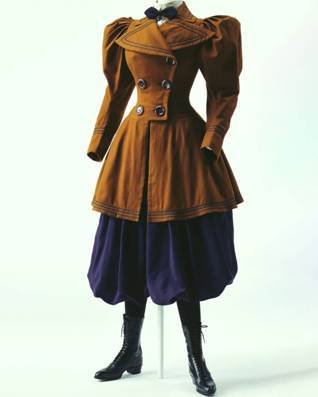
figure 1
First, a quick run-down of how underpants led to actual fashionable dress. In the better part of the 19th century, women had no need of underpants because of the many layers they donned as part of their dress ritual. During the Regency period, some women, not yet incumbered by hoops and bustles, would sometimes wear male-style underpants if they couldn't resist a dress made from a sheer fabric. It meant less need for extra petticoats as well as a guarantee that nothing private would be exposed in dubious, uncontrolled light.
Usher in the Victorian era and hoop skirts and petticoats were sufficient to satisfy modesty.
In the early 1900s we begin to see the emergence of pantaloon-chemise combos, slips, and various types of corsets that are beginning to look more like the modern girdle. (Figure 2)
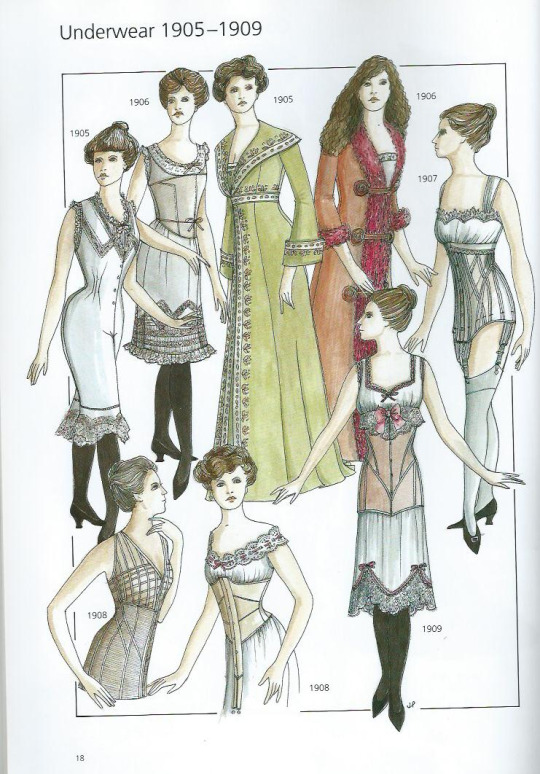
figure 2
The first woman in history to wear trousers was Elizabeth Smith Miller, known as Libby, in 1851. The popularity of the ‘pantaloon’ style, however, was due to Amelia Jenks Bloomer, an American women’s rights advocate and publisher of the magazine, The Lily. Through the magazine, Amelia helped to popularise ‘bloomers’ in the late 1850s, and hence, the bloomer style was consequently named after her.
“As soon as it became known that I was wearing the new dress, letters came pouring in upon me by hundreds from women all over the country. They were making inquiries about the dress and asking for patterns. It showed how ready and anxious women were, to throw off the burden of long, heavy skirts,” Amelia Jenks Bloomer wrote at that time. Shortly after, the style started to gain a lot of media recognition. The newspapers of those days described the style as: “Pantaloons" or ‘Turkish trousers" – "men-garments designed specifically for women.”

figure 3
Amelia suggested to women to wear less tight clothing and more comfortable clothing – women's trousers – a very radical idea for the times. They were very wide trousers, narrow at the ankle, with a short skirt on top. The idea was then revived in 1881 by viscountess Haberton, who founded The Rational Dress Society in England, a movement that replaced the use of women's dresses in the name of health and hygiene, proposing the use of wide trousers or pant-skirts. (Figure 3)
Women in pants were intimidated, harassed, and ridiculed to the point that, by 1859, even the most daring, including Jenkins Bloomer, gave up their fight for pants.

1890's cigar-box lid depicting a satirical scene of women in pants and smoking cigars.
That, however, is obviously not the end of it. Stay tuned for part 2.
Sources:
Fashion History Timeline
messynecychick.com
scuola le leonardohttps
Ethnologia Europaea
History Extra
#fashion history#the history of bloomers#women's fashion history#history of pants for women#early women's rights#19th century fashion history#the resplendent outfit blog#history of underwear#victorian fashion history
27 notes
·
View notes
Text
THIS DAY IN GAY HISTORY
based on: The White Crane Institute's 'Gay Wisdom', Gay Birthdays, Gay For Today, Famous GLBT, glbt-Gay Encylopedia, Today in Gay History, Wikipedia, and more … November 25



1832 – Dr. Mary Edwards Walker, American feminist and physician, born (d: 1919); American feminist, abolitionist, prohibitionist, alleged spy, prisoner of war, surgeon, and the only woman to receive the Medal of Honor. Although she was called by her male enemies "the most distinguished sexual invert in the United States," Dr. Edwards, although certainly a transvestite, was not necessarily a Lesbian. She was an ardent feminist, obsessed by the feminist dress-reform movement begun by Amelia Bloomer, and a mover and shaker in stirring up trouble whenever she was refused the right to do anything a man was permitted to do.
Prior to the American Civil War she earned her medical degree, married and started a medical practice. The practice didn't do well and she volunteered with the Union Army at the outbreak of the American Civil War and served as a female surgeon. She was captured by Confederate forces after crossing enemy lines to treat wounded civilians and arrested as a spy. She was sent as a prisoner of war to Richmond, Virginia until released in a prisoner exchange.
She eventually was awarded the Congressional Medal of Honor for her work; and she became the first woman the U.S. permitted to dress in male attire - a right granted by Congress, no less! That she lived together with a younger feminist, Belva Lockwood, after she divorced her husband is provocative, but hardly proof that either of them were Lesbians. Eventually, Dr. Walker moved out of step with her sister feminists because her taste in dress offended them. It was one thing to wear men's trousers - that was at least practical - but it was quite another thing to go whole hog, as did Mary Walker. She affected shirt, bow tie, jacket, top hat and cane. A very full discussion of this fascinating woman appears in Jonathan Katz's Gay American History..


1892 – Stewart Mitchell (d.1957) was an American poet, editor, and professor of English literature. Mitchell’s editorship of The Dial magazine signaled a pivotal shift in content from political articles to aesthetics in art and literature.
Mitchell was born in Cincinnati, Ohio. After graduating from Harvard University in 1916 he taught English literature at the University of Wisconsin. He resigned his position for political reasons, frustrated that he was forced to give a "politician's son who should have been flunked" passing grades. Mitchell enlisted in the army, serving in France until he was discharged as a private two years later.
Mitchell returned to the United States and was hired by Scofield Thayer and James Sibley Watson as managing editor of their joint project, The Dial. Mitchell, in association with Gilbert Seldes, was managing editor from 1919-1920. His appointment as editor marked a shift in the influential, modernist little magazine’s focus on politics to an artistic, literary theme.
Mitchell’s work for The Dial involved not only editing but, as was common with the majority of The Dial's editors, active involvement with and submissions to the creative or literary content.
Mitchell’s associating with The Dial proved advantageous and profitable to his own literary career. He completed and sold a volume of poetry that was published in 1921. Several of the poems in his collection were first printed in The Dial. These were reprinted with permission from Scofield Thayer. Following Mitchell’s resignation as editor, he continued to submit book reviews as well as poetry.
His desire to travel led Mitchell to give up editorship of The Dial and pursue further education abroad. In 1922, following two years’ study at the University of Montpellier and Jesus College, Cambridge, he returned to the States and lived with his elderly aunt in New York. Mitchell privately studied foreign language and literature, focusing on French and Greek, before returning to Harvard and graduating with a Ph.D. in Literature in 1933.
While completing his degree he also worked as editor for the New England Quarterly in 1928. The following year he gave up his position to become editor for the Massachusetts Historical Society. It was as a historical editor that Mitchell, according to his associates, truly excelled. His "naturally keen memory and sharp eye, coupled with a sure ear for words and an occasionally brilliant wit, permitted him to excel." After eleven years' service he resigned but was recalled in 1947 as Director and editor.
Mitchell's long-time partner was Richard David Cowan (1909-1939), a student of Cornell University in the 1920s who met Mitchell in the 1930s and they lived together since then. When Mitchell died in Brookline, Massachusetts in 1957, he was buried alongside Richard Cowan, who had died before him.
While at Harvard in his youth, he befriended the poet e.e. cummings who drew the the above sketch of Mitchell.


1913 – Robert Friend (d.1998) was an American-born poet and translator. After moving to Israel, he became a professor of English literature at the Hebrew University of Jerusalem.
Friend was born in 1913 in Brooklyn, New York, to a family of Russian Jewish immigrants. He was the eldest of five children. After studying at Brooklyn College, Harvard and Cambridge, he taught English literature and writing in the U.S., Puerto Rico, Panama, France, England, and Germany. He settled in Israel in 1950, where he lived the rest of his life. He taught English and American Literature at the Hebrew University of Jerusalem for over thirty years. He was well known in Israel as an English-language poet and a translator of Hebrew poetry.
Robert Friend was gay, and his sexuality found expression in his poetry well before the Stonewall era. According to Edward Field in the Greenwood Encyclopedia of American Poetry, Shadow on the Sun is "remarkable in that, for its time, it contains so many poems about the author's homosexuality." Friend's openness continued throughout his writing career.


1942 – Rosa von Praunheim is a German film director, author, painter and gay rights activist. Openly gay, he is one of the initiators of the gay rights movement in Germany.
A prolific director, he has made over fifty feature films. He began his career associated to the New German Cinema as a senior member of the Berlin school of underground filmmaking.
Born Holger Mitschwitzki, he spent his early years in East Berlin. In 1953, he escaped from East Germany with his family to West Germany. In the 60s, he took the artistic female name Rosa Von Praunheim to remind people of the pink triangle that homosexuals had to wear in Nazi concentration camps.
A pioneer of Queer Cinema, von Praunheim has been an activist in the gay rights movement. He was an early advocate of AIDS awareness and safer sex, but has been a controversial figure even within the gay community. His films center on gay related themes and strong female characters. His works are characterized by excess and employ a campy style. His films have featured such personalities as Jayne County, Vaginal Davis, Divine, and Jeff Stryker.
Praunheim's first big feature film was produced in 1970: Die Bettwurst(The Bolsters), a parody of bourgeois marriage. It became a cult movie, which had a sequel in 1973 (Berliner Bettwurst). In the same year, he also caused a stir with his documentary It Is Not the Homosexual Who Is Perverse, But the Society in Which He Lives which led to several gay rights groups being founded.Praunheim has centered his directorial efforts in documentaries featuring gay related themes. In the early 1970s he lived for some time in the United States where he made a series of documentaries about post- Stonewall American gay scene. In Army of Lovers or Revolt of the Perverts (1972-1976) he took on the American gay and lesbian movement from the 1950's to 1976.
Back in Berlin he made feature films such as Red Love (1980), Our Corpses Are Still Alive (1981), and City of Lost Souls (1983). These films were shown in film festivals worldwide.
With the irruption of the AIDS epidemic, Praunheim worked in a tetralogy of AIDS themed documentaries. A Virus Knows No Morals (1985), was one of the first feature films about AIDS. The documentaries Positive and Silence = Death, both shot in 1989 deal with aspects of AIDS activism in New York. Fire Under Your Ass (1990) focuses about AIDS in Berlin.
In Germany Rosa was very vocal in his efforts to educate people about the danger of AIDS and the necessity of practicing Safer Sex. These efforts alienated many gays who came to consider him a moralistic panic-monger. He would remain a highly controversial figure in his native country. On 10 December 1991 Praunheim created a scandal in Germany when he outed, among others, the anchorman Alfred Biolek, the comedian Hape Kerkeling and wrongly the actor Götz George in the TV show Explosiv - Der heiße Stuhl as gay. After the show several celebrities had their coming out. In 1999 he made Geisendörfer Medienpreis for Wunderbares Wrodow, a documentary about the people in and around a German village and its castle.
He lives in Berlin with his companion and assistant Oliver Sechting.


1963 – Kevin Chamberlin is an American actor. He starred as the butler, Bertram on the Disney Channel Original Series Jessie. He is openly gay.
Chamberlin has been nominated for Drama Desk and Tony Awards for Dirty Blonde (as Charlie), Seussical (as Horton), and The Addams Family (as Uncle Fester). Additional Broadway theatre credits include My Favorite Year, Triumph of Love, Abe Lincoln in Illinois, Chicago, and The Ritz.
He also appeared in the 1999 gay-themed movie Trick, and in Die Hard with a Vengeance as an enthusiastic NYPD bomb defusal expert. In Lucky Number Slevin, he again had a supporting role as a New York police officer.
Chamberlin's most recent work includes the role of Aron Malsky in the NBC prime-time series Heroes. He also made an appearance in a Law and Order: Special Victims Unit.
Chamberlin previously appeared as Uncle Fester in the musical The Addams Family, a role for which he won a Broadway.com Audience Award for Favorite Performance By a Featured Actor In a Broadway Musical.
He has said of his time with The Ritz:
We have a very large gay audience, which is funny, because some female friends of mine went to a preview and were exclaiming, "There was no line to the bathroom at intermission! It was all on the men's side." Someone actually walked out last night and had a row with the director. She was like, "I can't believe the Roundabout is putting on such flagrantly gay plays!" I mean, look at the poster, for God’s sake! And really, it’s a 35-year-old play. There’s nothing offensive — it just happens to take place in a gay bathhouse. This is pre-AIDS, in the middle of the sexual revolution. [Playwright] Terrence McNally was saying that it was an amazing, celebratory time of sexual freedom and also freedom for gay men. Where else could you go to have sex and watch Bette Midler sing at the same time?


1968 – Craig Seymour is an American writer, photographer, celebrity interviewer, music critic and former stripper. He was born in Washington, D.C.. He has written for The Washington Post, Entertainment Weekly, Vibe, and Spin, among other publications, and has served as pop music critic for The Buffalo News and the The Atlanta Journal-Constitution. Heis now Associate Professor of Journalism at Northern Illinois University. He lives in Chicago.
He has interviewed and profiled some of the biggest names in music, including Janet Jackson, Mariah Carey, and Luther Vandross, who granted him numerous interviews. Seymour has also been a music analyst for CNN's Headline News.
As a graduate student at the University of Maryland in the 1990s, Seymour started frequenting and working in the strip clubs in Washington D.C. while writing his master's thesis: "Desire and Dollar Bills: An Ethnography of a Gay Male Striptease Club." He used these experiences to write the book All I Could Bare: My Life in the Strip Clubs of Gay Washington, D.C. Seymour stated that stripping gave him the confidence he needed to interview big stars like Mariah Carey.
In an interview with Dallas Voice, Seymour credited his stripping career with "the ease I had asking celebrities extremely personal questions, especially those having to do with sex and relationships. After all, when someone is playing with your dick in public, it's not only potentially awkward for you, the one being played with, it can also be weird for the person doing the playing, because he is exposing his desires so nakedly in front of other people."


1970 – Yukio Mishima (b.1925), homosexual Japanese author, commits seppuku (ritual suicide).


1997 – In South Africa, a demonstration was held at the Johannesburg High Court in support of an application to decriminalize sex between men. South Africa becomes the first country to enact a constitutional ban outlawing sexual orientation discrimination.


5 notes
·
View notes
Text

Miss Charlotte and Miss Susan Cushman in the characters of Romeo and Juliet, print by Thomas Fairland after Margaret Gillies, c. 1840-1852 (British Museum).
There is arguably no other epoch in American history so tenaciously haunted, vexed, and titillated by the practice of cross-dressing than the 1840s and 1850s. Bloomers, named after Amelia Bloomer, then promenaded the streets in trousers (pantaloons) and actresses like Charlotte Cushman were seen to play "breeches" (male) parts on stage to mixed responses. Cushman in the role of Romeo, for instance, "had an extensive female following", and a lady in the audience was reportedly heard to whisper, "Miss Cushman is a very dangerous young man."
— Etsuko Taketani, “Spectacular Child Bodies: The Sexual Politics of Cross-Dressing and Calisthenics in the Writings of Eliza Leslie and Catharine Beecher,” The Lion and the Unicorn, September 1, 1999, doi.org/ 10.1353/uni.1999.0037. (Google Drive link)
#1840s#1850s#victorian#gender#queer history#lgbtq history#charlotte cushman#crossdressing#early victorian era#breeches roles#en travesti#this paper isn't on sci hub so i provided a download link you're welcome#thanks to my academic library access
70 notes
·
View notes